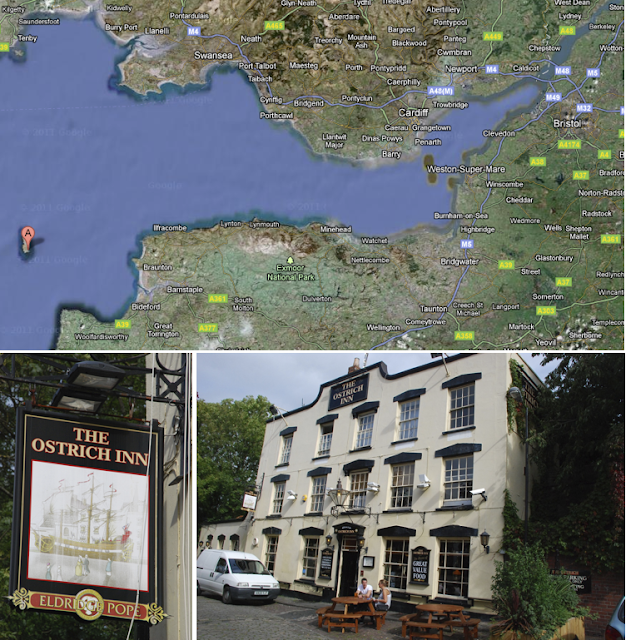Water certainly seems to be the theme of my Bristol experience so far... the water is the first thing that I see when I look out the window in the morning. It tells me the weather (mirrored or rippling, sparkling or dull gray, dimpled with dots of rain or reflecting the sodium light of lamps still lit when I get up). The boat traffic on the river is also an endless source of fascination... In this, my last post for awhile (I head back to Eugene on Saturday, and will see many of you in the next month) I thought that returning to the water was appropriate.
Last Sunday was Susie and Eric’s last day with me... as it was sunny and clear in the morning, I suggested that we return to Bradford-on-Avon and follow the footpath along the canal back to Bath (a walk of about 9 miles). I had done the walk a couple of summers ago with Mark, Alison and my graduate student Isolde. The walk was different last weekend, with autumn gold and brown replacing summer greens and pinks. But the stillness of the canal waters was the same, the reflections from the water enhancing the colors of the trees above.
The path follows the Avon canal, which parallels the Avon River. Apparently “Bristol Avon” is the proper name of the river, to distinguish it from all the other Avon rivers in the UK - “Avon” derives from the Welsh word “afon”, which simply means river. The Avon is a twisting turning river... it starts in Gloucestershire and takes 75 miles to travel to the Bristol Channel (a 19 mile straight line distance). As noted in an earlier post, the lower part of the Avon River (in Bristol) is strongly tidal and thus poorly suited to regular boat traffic (hence the Floating Harbor). However, navigable rivers were a general problem in England, particularly when the Industrial Revolution upped the demand for transport of goods and services. For this reason, England was apparently the first country to establish a nationwide canal network. The project was started by King James (of the Bible translation fame... this year is the 500th anniversary! of that translation) in 1605 (same king, same year as the Guy Fawkes debacle). In this region, the Kennet canal was opened in 1723 and the Avon in 1727 - the two systems now join in Bath and become the Kennet-Avon canal between Bath and Bristol, where it marks the boundary between Somerset and Gloucestershire. For those of you who have read “The Map that Changed the World”, remember that William Smith was a surveyor for the Somerset Coal Canal Company (he lived not far from Bath)... it was his canal work that led him to construct his geologic map of the UK (one copy of which hangs in the tea room in the department). The most remarkable aspect of the canal between Bradford-on-Avon and Bath (at least for those of us from the western US) is that for much of the distance the canal sits high above the river, and actually crosses above the river in a couple of places... “How interesting” said Susie, “a bridge of water.”

The current canal system is used primarily for pleasure boats (such as Jack de Crow). The most common of these are the “narrow boats”, so named because of their dimensions (maximum width 7 ft; maximum length 70 ft), dimensions required for boats to fit through the smallest locks and canals in the national network. Some boats are rented (particularly over the summer); others are permanent homes, as indicated by the gardens, bikes, kids toys and hand-painted signs that make each boat distinctive. At this time of year most boats are moored, with their owners preparing for the winter. However, there were still some boats puttering through the canal system at a very leisurely (no wake) pace, steered by a tiller in the stern. It looks like a very relaxing mode of travel, particularly given the frequency of local pubs and picturesque towns along the way. Our walk wasn’t quite as leisurely, as the low sun created long shadows even in the middle of the day, reminding us of the early fall of darkness. We made it to Bath shortly after sunset. As we walked through the town, the lights of the shop windows against the darkness highlighted the charm of the famous Pulteney St. bridge across the Avon, which is lined with shops like the Ponte Vecchio in Florence. We found a little tea house on the bridge where we could satisfy Susie’s passion for British afternoon teas, rest our feet, and gaze over the stair-stepped weir that punctuates the Avon’s flow through the city of Bath.

This weekend also boasted a glittering day, as Saturday dawned clear and sunny. I was hoping to crew in a sailing race that day, but the skipper had to cancel because his wife was sick. I satisfied myself with wandering down the harbor alongside the morning race, and then checking in on the afternoon race as a break from proposal writing! Saturday evening was North American Thanksgiving - an annual gathering of the numerous Earth Science student and staff members from the US and Canada...








































